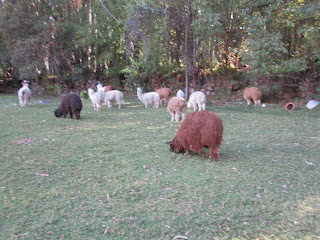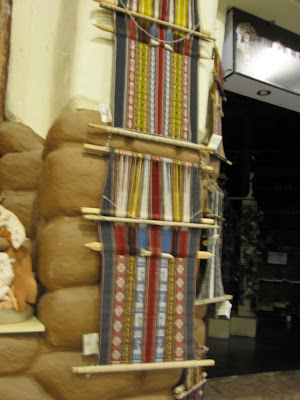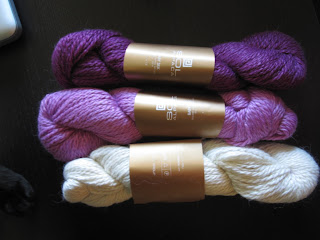It was a long trip to get to Cuzco - we left on Friday afternoon and arrived midday Saturday. We stayed at a place called The Garden House, which was a great hotel in the city. It is run by 2 sisters who are both very warm and made us feel at home there. One of them spoke excellent english so communication wasn't a problem. They gave us a cell phone with their number programmed into it to use in case of an emergency, or just to call a cab. Our room was very big - it had a main room to sleep in and a sitting room. And the hotel was in a fenced off area in the city with gardens all around it, so when we looked out the window we had a nice view of the greenery.
Cuzco is at a very high altitude in the Andes mountains - it is at 11,200 feet, so it took a bit of time to acclimate. The owner of the hotel had oxygen should we need it, however the local medicine is coca. Coca is a very important plant around there and has been for hundreds of years. It can act as an antibiotic and helps the body absorb oxygen, helping with the altitude. When we arrived there was a tea station set up in our room with some coca tea to help us acclimate.
Greg was fine adjusting to the altitude, but it took me a few days. My first night I had a lot of trouble sleeping, but every day it got better. The coca tea definitely helped - it got rid of my headaches within a few sips. The Andes' people consider coca to be a sacred plant to them because of all of its benefits. It helps them with the altitude and it can act as an antibiotic as well, keeping the mouth clean. We stayed in Cuzco for 5 days, but I wish we were there for more because of that adjustment period.
Our first full day we went on a tour of the Sacred Valley. Our tour guide spoke only spanish, so it was a chance for both of us to practice our spanish. Surprisingly, I was able to understand most of it. What I didn't understand Greg was able to clarify for me. However, I still don't have the past tense entirely figured out so I did make a fool of myself on a few occasions.
Outside of Cuzco was mostly farmland. It was very beautiful, and a big contrast to the layout of the city. The Andes mountains were in the landscape, and the views were vast. We stopped by a market in Chinchero where they sold sweaters, scarves, backpacks, and handicrafts. I bought an alpaca brown sweater. Most of the things sold were handmade, like the weaving.
After that we stopped by a weaving town, Awana Kancha, to see how they made the yarn with which they did their weaving. Weaving is very popular around there, and some of the best weaving in the world is found in this area. They make it from scratch too, starting with the alpacas.
This is where they turn it into string and dye it. They had a spinning device they used to make it fine enough to weave with, and then they used natural dyes to color it.
This pot is cooking the color they use to dye the yarn. They use llama manure to start the fire to cook with, and then add the dye to the pot.
Here, each yarn is sitting in a bowl of what was used to dye it with. They used things like grains, corn, and leaves.
And here in between the dye bowls and yarn are the spinning devices they used to make the yarn fine.
We stopped by a weaving store with all handmade woven pieces. To give you an idea of just how intricate their woven pieces can be, I snapped this picture. It is entirely hand woven.
Incredible, right? I can't even comprehend the skill that went into making that. Here are some looms in progress.
I didn't buy any weaving, just the alpaca sweater. Greg bought a beautiful baby alpaca sweater also.
Because alpaca and weaving and wool are very popular around the area, so is knitting. I was able to find some baby alpaca yarns to knit with, at great prices too.
We saw some of the ruins from the ancient Incan empire in Ollantaytambo, but my photos didn't do them justice. Even though the cities are in ruins, you can tell that the Incas were brilliant architects. They worked with very heavy stones to build their cities, and in most cases they cut the stones to fit together perfectly. I have more pictures of that from Machu Picchu. They used the larger stones at the base of the city, and at the higher points they used smaller stones and mud to keep them in place.
Notice how perfectly cut this stone is that we're sitting on - every angle on it is 90 degrees.
One thing I never did adjust to in regards to the altitude was climbing stairs. And exploring these ruins involved climbing many stairs. Normally I am all about climbing stairs. At Dreamworks I made it a point to climb the 4 flights of stairs every day, and I usually choose it over an escalator when I have the choice. But here I was getting short of breath after less than a flight. It was a great feeling being able to climb stairs again when we reached the Lima airport.
We passed this statue on our drive, its design is in traditional Incan style.
Almost all of the land around the Sacred Valley is cultivated for crops. They grew some grains that we don't have, a lot of quinoa, and a few different types of corn. There was one corn in particular that was really good - it was called Choclo. It's grown without chemicals and has a starchy taste. Here Greg's holding a cob of it. It's hard to tell from this picture, but the kernels are a lot bigger than our conventional yellow corn. It was served with a locally made cheese instead of butter. I didn't have the cheese, but Greg said it was good.
They also served a popcorn version of this corn, which was also delicious. It was a bit chewier than our normal popcorn, and sweeter.
Here's an overhead view of the crops on the land.
At the end of the tour, we stopped by a wildlife rehabilitation center. Its mission was the same as the one I've been working at, but they handle much bigger animals, and most of them come from the amazon.
These wildcats were taken from a disco down in Lima. The owners of the disco had them on display and people could pay to pet them. They were declawed so unfortunately they can't be released again. Most animals they get they are able to release in a few months.
These are vicunas, they are related to the llama. They produce the softest, rarest, and most expensive wool in the world. And they are very aggressive creatures, so it is hard to sheer them.
At the end of our visit to the sanctuary I got to pet a stray kitten that came running up to us. There were many stray cats and dogs we saw around Cuzco and the Sacred Valley, but this was the only kitten. I bent down to pet it and it jumped right into my lap and started purring.
Our last full day in Cuzco we explored the Plaza de Armas, which is a big touristy area with a lot of shopping and activity. We stopped by a chocolate museum while we were there, where we tried chocolate tea. It was made by steeping the cocoa bean husks. I thought it was delicious - it didn't taste like chocolate milk or hot chocolate, it wasn't that thick, but still had the distinctive dark chocolate taste.
Chocolate is becoming a more prominent crop down in Peru. Many of the coca farmers don't like the fact that their sacred crop is being used in the illegal production of cocaine, so they are switching over to producing cocoa instead.
We were in the Plaza de Armas on June 19th, and they were preparing for a big celebration on June 24th. The sun plays a very prominent role in the Incan culture and worship, and June 24th is right around their winter solstice. It is called the Inca Sun Festival. To celebrate, the students all put on a dance with music and costumes around the square. They were practicing when we were there.
The Plaza de Armas felt very safe the entire time we were there. There were many tourists, even late into the night and many of the shops stayed open after dark. The shopping was great too - there were some beautiful alpaca stores where they sold sweaters, shawls, scarves, and yarn. I would have loved to stay a few more days to see some more of the markets.
The host of the hotel we were staying at was talking to us about how most people who live in Cuzco can't find it in them to leave. The city is not without its share of problems. There is corruption in the government, and there is a lot of development happening around the area without a city planner, so many of the buildings look disjointed, and quite a few are left unfinished when the owner runs out of money. You cannot drink the water either. However, there is a strong sense of community among the residents and something very romantic about the area. I think it has to do with the mountains. Like the ocean, the mountains are very calming to look at. Despite the city's size, it is dwarved by having them in the landscape.































